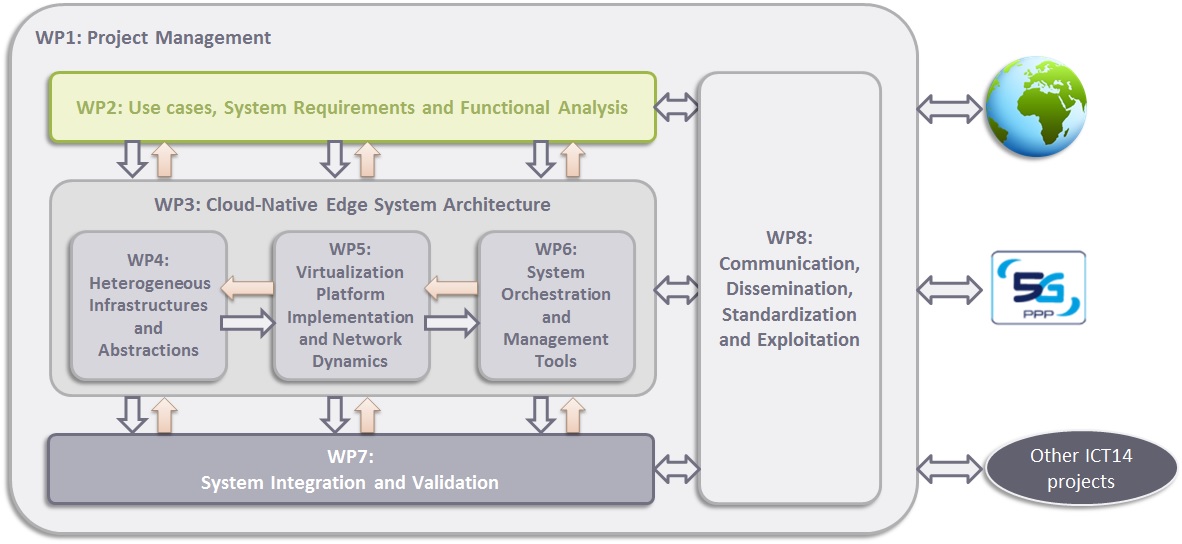The planned duration of the project is 30 months. We envisage three phases and a model producing significant usable results also during the project and not only at the end of it: i) requirements analysis, modelling, initial design and specifications; ii) core design, platform development, initial evaluation; iii) use case deployment, development, integration, final evaluation.

As shown in the figure above, we have eight Work Packages:
- WP1: Project Management, led by CNIT
- WP2: Use cases, System Requirements and Functional Analysis, led by British Telecom
- WP3: Architecture and Programming Interfaces Specification, led by ALCATEL LUCENT,
“contains” the following three WPs, each of which caters for a specific level of the system - WP4: Heterogeneous Infrastructures and Abstractions, led by INTEL
- HW modelling, profiling and selection; performance, scalability and portability aspects of multiple hardware platforms
- WP5: Virtualization Platform Implementation and Network Dynamics, led by NEC
- solutions for platform-agnostic programmability and configuration, taking into account the dynamics of virtual network functions
- WP6: System Orchestration and Management Tools, led by REDHAT
- provisioning and control framework, including automated security verification of network processing code
- WP7: System Integration and Validation, led by Portugal Telecom
- WP8: Communication, Dissemination, Standardization and Exploitation, led by CITRIX
The overall approach and methodology proceed through the following stages:
Design. The thorough analysis and functional breakdown of use cases carried out in WP2 will permit us to identify the elementary primitives and functional blocks which will candidate to be part of the SUPERFLUIDITY data plane processing architecture delivered by WP3. As discussed in details in the relevant WP3 description, we will address the dichotomy emerging between (a) elementary primitives (for maximum reuse and sharing), and (b) as complex components (for maximizing vendors’ intellectual property and for simpler and faster service deployment and provisioning), via a multi-level, hierarchical, architectural data plane decomposition of radio and network processing primitives.
Integrated trial validation. A subset of use cases, selected among the most compelling ones proposed throughout the project (and from other projects), and at the same time permitting to assess multiple SUPERFLUIDITY research objectives, will be concretely implemented and validated in realistic trial scenarios. To this end, SUPERFLUIDITY will deploy a controlled and integrated trial scenario combining various distributed assets. The key differentiators of SUPERFLUIDITY here will be a unified cloud control spanning over the various local cloud infrastructures so as to achieve a successful heterogeneous deployment.
Targeted stand-alone validation. While an integrated demonstration is clearly a very compelling objective, we believe that additional stand-alone demonstrations are strictly necessary to validate, in a specific and controlled environment, functional aspects as well as specific KPIs hard to measure in an integrated environment. To this purpose, additional targeted assessment activities and experiments will be carried out at different partners’ premises to validate performance, scalability, response times and latency, and also functional aspects which cannot be easily isolated in an integrated trial, but rather benefit from a dedicated environment for executing “crash/stress tests” (so as to stress scaling and capacity limits of specific parts or functions comprising the system), for testing multiple traffic patterns and load conditions, for recreating failure and/or attack conditions and/or rare conditions.
